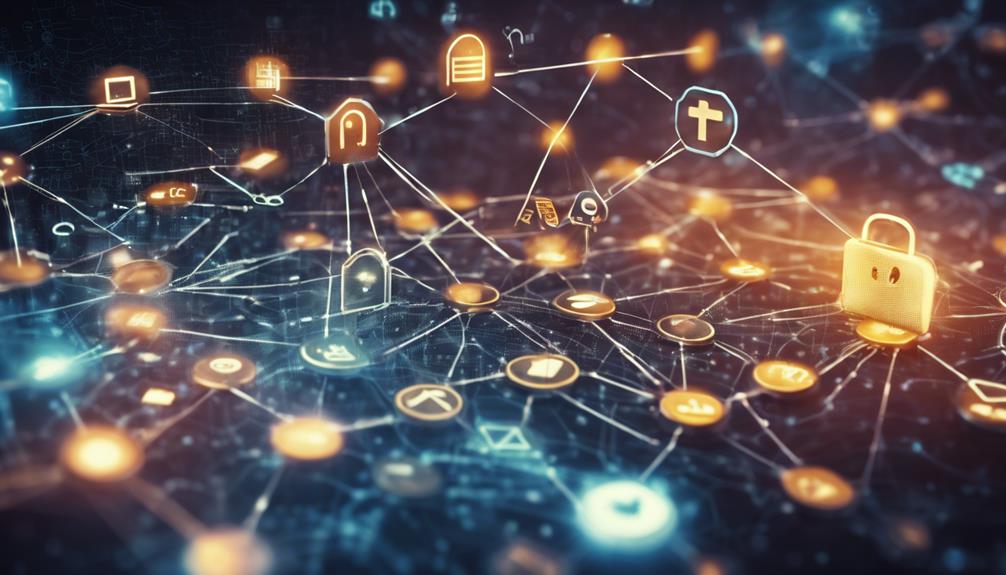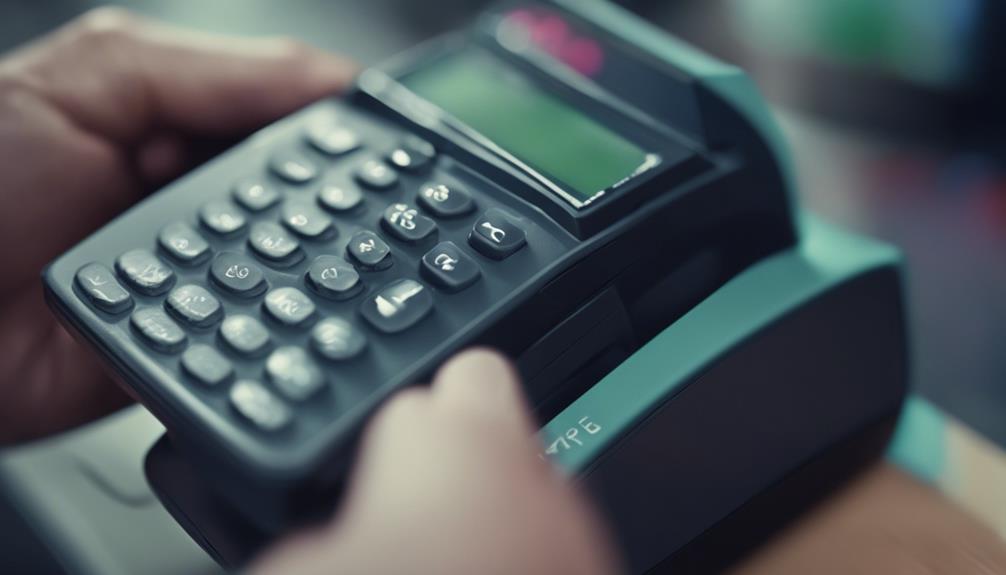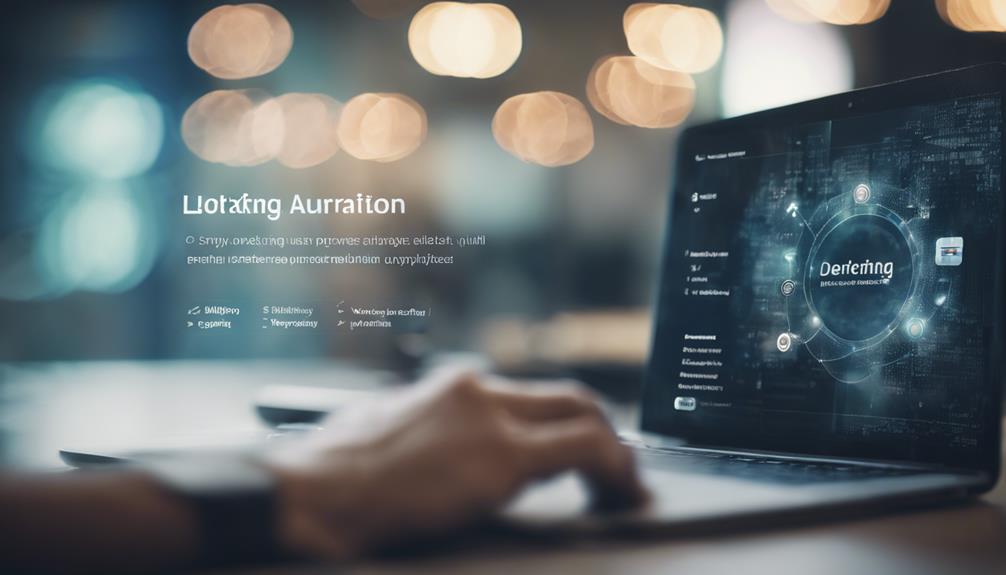To strengthen payment security, employ advanced strategies like encryption, multi-factor authentication, and fraud detection technologies. Educate customers on recognizing scams and secure transactions. Maintain updated software, secure hardware, and comply with industry regulations. Implement end-to-end encryption and phishing prevention measures. Enhancing security requires a holistic approach involving technology, education, and compliance to safeguard sensitive payment information effectively. Further insights are available for those seeking thorough solutions to fortify payment security.
Key Takeaways
- Implement end-to-end encryption for comprehensive data protection.
- Integrate advanced fraud detection technologies for real-time analysis.
- Utilize multi-factor authentication to enhance user verification processes.
- Regularly update software and hardware security measures for robust defense.
- Comply with industry regulations like PCI DSS and GDPR for enhanced security.
Data Protection Measures

To enhance payment security, implement key data protection measures such as encryption, tokenization, and multi-factor authentication. Encryption plays a vital role in safeguarding sensitive payment information by converting it into a coded format that can only be deciphered with the right encryption key.
By adhering to PCI DSS standards, which require the use of encryption to protect cardholder data, you can greatly reduce the risk of unauthorized access and data breaches. Additionally, incorporating multi-factor authentication adds an extra layer of security by verifying user identity through multiple forms of validation, such as passwords, biometrics, or security tokens.
This proactive approach not only aligns with industry regulations but also improves the overall security of payment transactions. By embracing these data protection measures, like encryption, multi-factor authentication, and adhering to PCI DSS standards, you're taking significant steps towards fortifying the security of your payment processes and safeguarding sensitive information from potential threats.
Customer Education on Security

Enhancing payment security through customer education is essential in safeguarding your online transactions.
Security awareness campaigns and interactive training modules can equip you with the knowledge to recognize and thwart common scams.
Security Awareness Campaigns
Empower yourself with the knowledge to spot phishing scams and create strong passwords through engaging security awareness campaigns. These campaigns play an important role in educating customers about the risks associated with online transactions.
By emphasizing the significance of HTTPS encryption and recognizing secure payment gateways, customers can make informed decisions when making online payments. In addition, educating customers on the dangers of using public Wi-Fi for sensitive transactions enhances their awareness of potential security threats.
Security awareness initiatives are designed to empower individuals to actively participate in safeguarding their financial information. Stay informed and vigilant to protect yourself from online threats and promote secure transactions.
Interactive Training Modules
Strengthen your understanding of online payment security by engaging with interactive training modules that focus on educating customers about creating secure passwords and identifying potential phishing scams. These modules are designed to enhance your knowledge in the following ways:
- Learn the importance of secure passwords.
- Identify and avoid falling for phishing emails.
- Understand the risks associated with using public Wi-Fi for secure payments.
Regular Software Updates

Regular software updates are essential for maintaining the security of your systems. By regularly updating your operating systems, browsers, and payment software, you can prevent cyber attackers from exploiting vulnerabilities.
Ensuring compliance with the latest security standards through updates is vital for safeguarding your sensitive payment information.
Importance of Updates
To enhance payment security effectively, prioritizing regular software updates is essential. Keeping your software up to date plays a critical role in safeguarding your payment systems.
Here are some reasons why updating your software is important:
- Regular software updates patch security vulnerabilities and bugs, protecting your system from cyber threats.
- Outdated software is more susceptible to malware and ransomware, putting your payment security at risk.
- Updating guarantees that your software remains compatible with the latest encryption standards, maintaining secure transactions.
Security Vulnerability Prevention
Keeping your software updated is essential in preventing security vulnerabilities and maintaining a secure payment environment. Regular software updates patch security vulnerabilities and fix bugs that could compromise payment security. Outdated software serves as a common entry point for cyber attackers to exploit weaknesses in payment systems. Updating operating systems, browsers, antivirus software, and payment applications is crucial in implementing effective security controls and practices. By staying proactive with software updates, you enhance the overall security posture of payment processing systems and protect against potential security breaches. Timely software updates play a significant role in preventing cyber threats and ensuring a secure payment environment.
| Software Updates | Payment Security Vulnerabilities |
|---|---|
| Patch security vulnerabilities | Fix bugs that compromise security |
| Prevent cyber threats | Enhance security posture of systems |
| Update operating systems | Protect against potential breaches |
| Maintain secure payment environment | Implement effective security controls |
| Enhance overall security | Prevent exploitation by attackers |
Compliance With Regulations
Ensuring compliance with regulations necessitates consistently updating your software to maintain data security standards and protect customer information. Regular software updates play an essential role in meeting PCI DSS compliance and other regulatory requirements.
Here are some key points to keep in mind:
- Software updates: Keep your systems up-to-date to address security vulnerabilities promptly.
- Legal penalties: Failure to update software can result in severe consequences, including fines and legal risks.
- Protecting customer data: Updated software helps safeguard payment information and ensures compliance with industry standards.
Hardware Maintenance Practices

Regularly updating and maintaining Hardware Security Modules (HSMs) is essential to ensure the secure storage of cryptographic keys. By implementing physical security measures such as tamper-evident seals and secure storage facilities for hardware components, you can enhance the protection of sensitive data. Conducting routine checks and audits of hardware components is vital to detect and prevent any tampering or unauthorized access, ensuring the integrity of your systems.
Incorporating Secure Elements (SEs) in devices like smartphones provides a secure environment for storing payment credentials and other sensitive information. Remember to enforce strict access controls and authentication protocols to restrict physical access to hardware components and safeguard sensitive data from unauthorized individuals.
Maintaining hardware security is a continuous process that requires diligence and adherence to best practices. By staying vigilant and proactive in your hardware maintenance practices, you can greatly reduce the risk of security breaches and protect your payment systems from potential threats.
Industry Regulation Compliance

How can industry regulation compliance enhance the security of payment processes and protect sensitive data?
Ensuring compliance with regulations such as PCI DSS, GDPR standards, and CCPA guidelines plays a vital role in safeguarding payment transactions and securing valuable information. Here are three key ways in which adhering to industry regulations can strengthen payment security:
- PCI DSS Compliance: By following PCI DSS requirements, businesses can establish robust measures to protect payment card data, reducing the risk of fraud and unauthorized access.
- GDPR Standards: Adhering to GDPR standards not only helps in safeguarding customer data but also fosters trust in payment processes, enhancing overall security and transparency.
- CCPA Guidelines: Following CCPA guidelines ensures that businesses are transparent about their data collection and handling practices, promoting accountability and data privacy.
Meeting these regulatory standards demonstrates a commitment to data security, reducing legal vulnerabilities and creating a more secure payment environment for all parties involved.
Fraud Detection Technologies Integration

To optimize payment security, integrating fraud detection technologies is essential in detecting and preventing fraudulent activities effectively. Fraud detection technologies, such as machine learning algorithms, play an important role in analyzing transaction patterns in real-time to flag potentially fraudulent actions. By integrating AI systems into payment processing, businesses can enhance fraud detection accuracy by learning from historical data and adapting to emerging trends and patterns swiftly.
Moreover, advanced tools like behavioral analytics and anomaly detection aid in identifying unusual behavior, helping companies thwart fraudulent transactions before they occur. Real-time monitoring using sophisticated fraud detection software is crucial in reducing the risk of financial losses due to fraudulent activities. Additionally, the integration of biometric authentication methods like facial recognition and fingerprint scanning adds an extra layer of security by verifying user identities, further fortifying payment security measures against potential threats. By leveraging these technologies synergistically, businesses can significantly enhance their fraud prevention capabilities and safeguard their financial transactions effectively.
Encryption Implementation

Integrating fraud detection technologies sets the foundation for robust payment security; now, let's shift our focus to the implementation of encryption for safeguarding sensitive data during transactions.
When implementing encryption for payment security, consider the following:
- Utilize Strong Encryption Protocols: Implement robust encryption protocols like SSL/TLS to protect payment information from unauthorized access and maintain data confidentiality.
- Maintain Data Integrity: Encryption plays an essential role in maintaining data integrity by preventing cyber attackers from intercepting and altering sensitive information during transmission.
- Defend Against Cyber Attackers: Implementing encryption practices acts as a barrier against cyber attackers attempting to access and misuse payment data.
Multi-Factor Authentication Setup

Are you looking to enhance your payment security with an additional layer of protection? Multi-factor authentication (MFA) is a powerful tool to bolster the security of your accounts and transactions. MFA requires users to provide two or more forms of verification, such as passwords, SMS codes, biometric data (like fingerprints or facial recognition), security tokens, or smart cards. By incorporating multiple factors for authentication, MFA greatly enhances security by adding layers of protection beyond just passwords.
One of the key benefits of multi-factor authentication is that it reduces the risk of unauthorized access even if one factor is compromised, adding an essential security measure to your payment processes. Many platforms and services now offer multi-factor authentication as an option to strengthen account security and prevent fraud. By setting up multi-factor authentication, you can significantly improve the security of your financial transactions and protect your sensitive information from potential threats.
End-to-End Encryption Deployment

When deploying end-to-end encryption, you benefit from heightened security measures and guarantee compliance with industry regulations.
This method safeguards payment data throughout the transaction process, making it extremely difficult for cybercriminals to access and decipher sensitive information.
Encryption Implementation Benefits
Strengthening payment security through end-to-end encryption deployment guarantees robust protection of sensitive data transmitted between parties, safeguarding against unauthorized access and potential breaches. When implementing end-to-end encryption, you benefit from:
- Enhanced data privacy: Only authorized parties can access and decrypt the information, ensuring confidentiality.
- Reduced vulnerability to cyber attacks: Encrypting data at both ends greatly lowers the risk of unauthorized access.
- Prevention of data breaches: By securing information throughout the communication process, end-to-end encryption eliminates the possibility of leaks.
These benefits make end-to-end encryption a crucial security measure that fosters trust and confidence in the integrity of payment transactions.
Compliance With Regulations
Implementing end-to-end encryption in accordance with regulations guarantees thorough protection of sensitive data throughout the entire transaction process, safeguarding against unauthorized access and potential breaches.
Compliance with standards like PCI DSS is essential for safeguarding sensitive information, as it mandates the use of end-to-end encryption to secure payment data. This encryption method ensures that data remains encrypted from the moment it enters the system until it reaches its intended destination, providing extensive protection across all transaction channels.
By adhering to these regulations and deploying end-to-end encryption, businesses can demonstrate their commitment to maintaining the confidentiality and integrity of customer payment information, thereby enhancing trust and security.
Phishing Prevention Strategies

To enhance payment security, users can educate themselves on recognizing suspicious emails, links, and messages as part of phishing prevention strategies. By being vigilant and informed, you can protect your sensitive information from falling into the wrong hands.
Here are some effective strategies to help you stay safe from phishing attacks:
- Implement Email Authentication Protocols: Utilize protocols like SPF, DKIM, and DMARC to verify the legitimacy of incoming emails and reduce the risk of falling for phishing attempts.
- Enable Two-Factor Authentication: Enhance your account security by setting up two-factor authentication, which adds an extra layer of protection by requiring additional verification steps beyond just passwords.
- Update Anti-Phishing Filters Regularly: Keep your anti-phishing filters and software up to date to make sure that you have the latest protection against evolving phishing techniques.
Frequently Asked Questions
How Can I Make My Payment More Secure?
To guarantee your payment more secure, consider implementing multi-factor authentication for an added layer of protection.
Tokenization can replace sensitive data with unique tokens, enhancing security.
Regularly updating encryption protocols guarantees secure data transmission.
Monitoring for suspicious activities and utilizing fraud detection systems in real-time can prevent fraud.
Complying with industry standards like PCI DSS maintains a secure payment environment.
These steps can help enhance the security of your payments.
How Can We Ensure the Safety of Our Payment Methods?
Wondering how to guarantee the safety of your payment methods? Implement tokenization for secure data handling. Use multi-factor authentication like biometric scans for enhanced verification. Update encryption protocols regularly and monitor for suspicious activities.
Employ fraud detection systems for real-time prevention. Comply with industry standards such as PCI DSS and GDPR. By following these steps, you can greatly enhance the security of your payment methods.
How Can We Ensure Security in E-Payments?
To guarantee security in e-payments, you should implement multi-factor authentication, tokenization, and encryption updates.
Monitoring for suspicious activities and using fraud detection systems are vital.
Adhering to PCI DSS compliance standards is also indispensable for a secure payment environment.
What Is the Best Payment Method for Protection?
When considering the best payment method for protection, you'll find that EMV chip cards offer solid defense against counterfeit fraud in face-to-face transactions.
Mobile payment options like Apple Pay and Google Pay utilize tokenization for secure transactions.
Virtual credit cards provide disposable numbers for online shopping, reducing data theft risks.
Biometric authentication methods, such as fingerprint or facial recognition, add an extra security layer.
Contactless payments with NFC technology offer secure and convenient transactions without physical contact.
Conclusion
To sum up, implementing advanced strategies for enhancing payment security is essential in safeguarding sensitive information and preventing unauthorized access. By utilizing data protection measures, educating customers on security practices, and ensuring regular software updates and hardware maintenance, businesses can reduce the risk of cyber threats.
Compliance with industry regulations, encryption implementation, multi-factor authentication, and phishing prevention strategies are also key components in maintaining a secure payment environment. Remember, staying proactive and vigilant is the key to staying ahead of potential security risks.










